Japan hosts fifteen St. Patrick's Day parades and Irish festivals each year, including the big ones in Tokyo. But what's behind this affection for Ireland in the country it is furthest from?
Recently I came upon an interesting statistic: Japan has fifteen Irish parades and festivals them each year. That made me do a double take. Fifteen? Why so many, I wondered?
Why would a country as far from Ireland as Japan bother their heads with us?
Read more: 10 tips for your big trip to Japan to watch Ireland play the 2019 Rugby World Cup
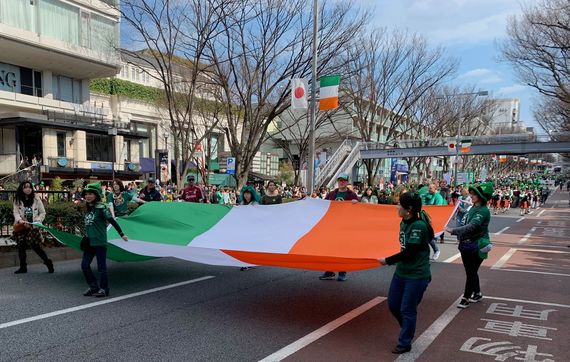
St. Patrick's Day in Tokyo is a surprisingly major public event
Do Irish people even know all these parades and festivals even happen in Japan I wondered, or that they've been happening there for decades now?
And do Japanese people know they are participating in a wider global greening that means that growing numbers of the Irish will think of them with real affection going forward?
We are much closer to each other than we know, it turns out.
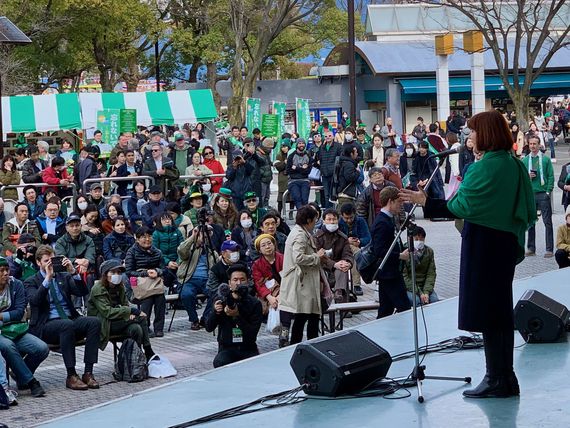
Minister Jospeha Madigan speaks to the crowd in Tokyo
In Tokyo, I was a guest of the Tokyo Visitors and Convention Bureau, who helpfully provided me with an interpreter for the annual I Love Ireland Festival in Yoyogi Park, organized by the Ireland Japan Chamber of Commerce.
Then later that day the Irish Network Japan (INJ) Tokyo Parade, Asia’s oldest and biggest St Patricks Day Parade was (led this year by Irish Minister for Culture, Heritage and the Gaeltacht Jospeha Madigan) stepped off on Omotesando Avenue with marching bands, musicians, dancers and even green tunic wearing samurai, led by the Parade Grand Marshal and Saint Patrick himself.
The atmosphere was carnivalesque. It's not the wintery grin-and-get-through-it effort we often see on Fifth Avenue.
Read more: 130,000 attend huge St. Patricks Day Parade and Festival in Tokyo, Japan
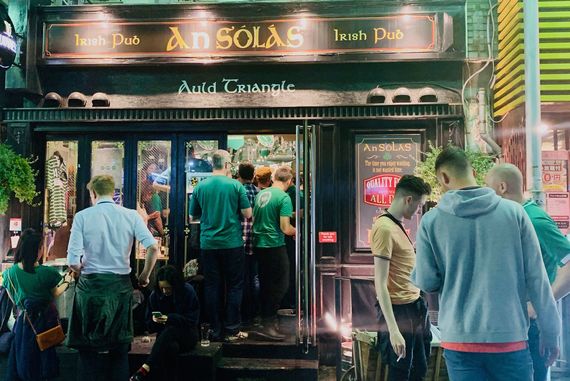
An Solas public house is a gathering spot for the Irish in Tokyo.
There were all-Japanese step dancers, céilidh bands, harp players, choral singers, hurley teams and mixed Japanese and Irish GAA clubs.
It was a huge parade, in other words, taking up both sides of the famous avenue, and providing Ireland and Irish culture with an enviable shop window in what is already one of the most exclusive shop windows in Tokyo itself.
180,000 people turned out on the day to watch Ireland turn Tokyo green. It was extraordinary.
Amhrán na bhFiann (The Soldiers' Song) as performed by the The Tokyo Pipe Band gets the St. Patrick's Day Parade off to a patriotic start in Japan 2019. #ProudToBeIrish #Tokyo #東京 #StPatricksDay ッピー #セントパトリックスデー #LáFhéilePádraig #GlobalGreening pic.twitter.com/dxgTCx6RLz
— Cahir O'Doherty (@randomirish) March 17, 2019
What became clear on my visit there is that the distance between us is becoming much smaller as Ireland's culture and economy strengthens its ties to Japan and Asia (the Irish government is building a new Ireland House in Tokyo, which will be its diplomatic flagship in Asia).
Irish tech companies, Irish food products, Irish financial services companies, Irish universities, Irish heritage goods and Irish culture have all made landfall here and their connections and ambitions are only growing.
But the sheer strength of the longstanding Irish Japanese links only become clear when you land in Tokyo. Irish pubs with Irish staff are everywhere, I discovered because of course, they are.
You can order traditional Irish stew or traditional Irish soy noodles (not Irish at all, but why quibble) as their cozy interior designs can evoke any old pub from Malin to Mizen.
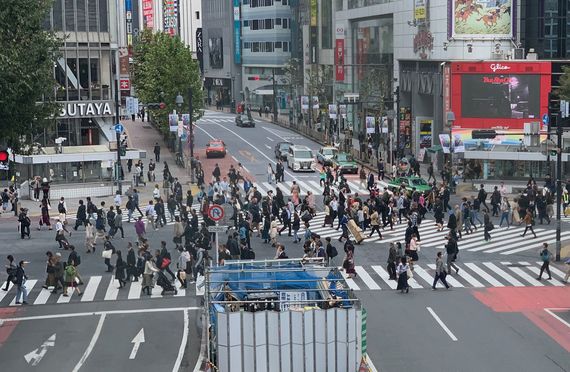
The famous Shibuya scramble crossing in Tokyo.
It's remarkable that all of this happens. It's remarkable we Irish have a strong presence in countries that most of us may never set foot.
Like mini-consulates, even our Irish pubs tell a story about who we are to the world: friendly, funny, tolerant, up for the craic – and here's a poster of our famous writers to remind you that we're also poets, thinkers, and philosophers, too.
It's putting our best face forward to the world, all this, it's a kind of soft power, and you'd be surprised just how far it travels.
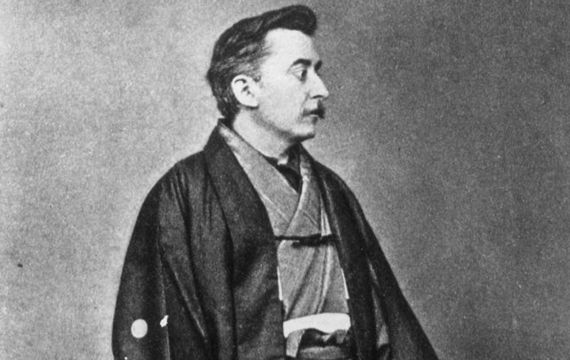
Irish Greek author (Patrick) Lafcadio Hearn
Meanwhile having the craic in Japan is exactly the same as in Ireland. Find a welcoming local and pull up a chair. Within minutes you'll be having a bi-lingual or tri-lingual conversation.
My first thought upon arrival in Japan was that I was very glad I brought some jackets and dress shirts, because looking around me at the airport when I landed, I started picking up on the fashion cues fast.
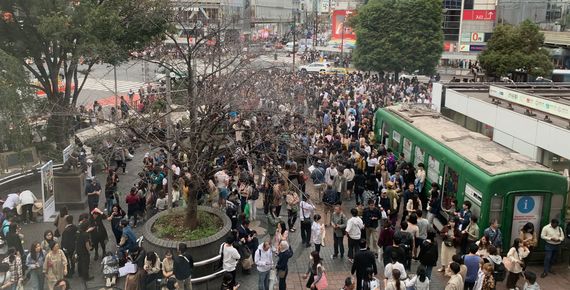
Shibuya is a famous meeting spot in Tokyo.
It's clearly a culture that prizes thoughtfulness in every interaction, but the other side of that is it that they also quietly celebrate eccentricity of outlook, a reflex of all that social conformity. These social contrasts fascinated me.
It's also possible to get deep inside your own head when you land in Tokyo: am I doing this right, did I order that right, am I wearing the right shoes, should I take my shoes off here, did I just bow correctly?
You are absolutely going to get some of these wrong because you weren't born here and don't know how it's done, so give yourself a break. You'll figure it out by taking a deep breath and looking around you. It's not rocket science, after all, it's just good manners.
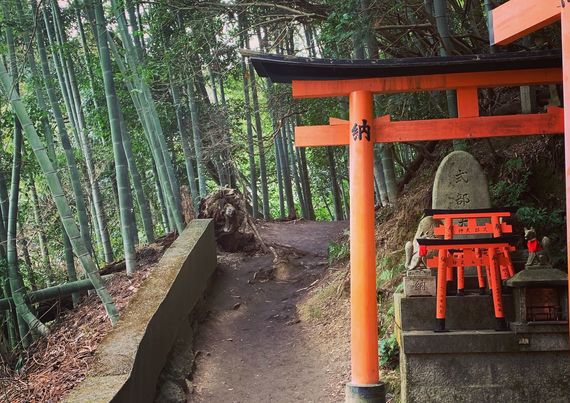
Ireland or Japan? Sometimes the Japanese landscape may force Irish visitors to do a double take.
It's very instructive to find yourself in the minority, for example, to visit a nation where everywhere that you look you are reminded of your otherness (less the 2% of the population are foreign-born).
This can be oppressive or liberating, depending on your outlook. Personally, I was thrilled. I felt relieved of the burden of being typical. Instead, I embraced my new status as an outsider, which was physical as well as cultural. Japan does that to you. It was quite fun.
But it was the small-scale, ground-level things I noticed first. There are no street names. How does anyone know what street you're on, I wondered? Then I noticed that the food on offer in any basic 7-Eleven is far fresher and better prepared than any of the gourmet offerings in Whole Foods here. I hate to be the bearer of bad news, but their food culture makes us look like we're not trying.

A word about those. For a start, those ultra-modern commodes are electrically powered. With the press of a button, the seats warm beneath you. Another button plays classical music. Another button makes a little metal extension appear to provide a spray of water that will make your visit extra hygienic (I'll spare you the details).
I only bring them up because they strike such a contrast to the west. Compared to Japanese ideas of personal hygiene, we must seem like barbarians, it occurred to me.
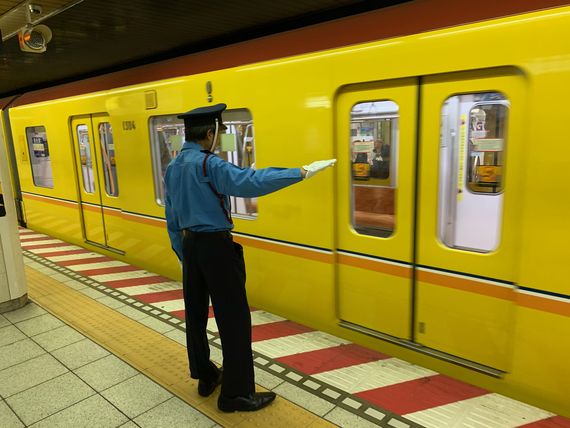
Guiding the trains at Shibuya station in Tokyo.
Other things astounded me. The precision of the Tokyo subways blew my mind. Trains arrived the very minute they were scheduled to, staffed by smartly uniformed men in caps with whistles, who kept their eyes on their watches to ensure things keep running on time. And this wasn't just locally, this was nationwide.
That was the only thing about Japan that gave me culture shock by the way: its sheer efficiency. Tokyo allows you to dream of what New York would look like if it actually worked.
On the streets, garbage men pick up trash cans with white gloves. There are very few public litter bins but no one ever litters. People wait for the traffic light to change from red to green before the cross the street, even if there are no cars in sight.
Everywhere people bow when they greet each other, strangers give right of way to each other, old people are immediately offered seats on crowded trains, it's always me second, not me first.
Visitors coming to Japan for the Rugby World Cup should know that their hotel visits are likely to be among the most memorable they have ever experienced. The level of personal care here is like nothing I have ever seen. I kept waiting for someone to appear and tell me I was on candid camera. No place can work this thoughtfully and this well, I wanted to say.
So if you are traveling over for the world cup this autumn don't be surprised if the thing you'll spend most time doing is reassessing your own country's claim to greatness against where you have just found yourself.
Throughout my trip, I stayed at the famous Tokyu group hotels in Tokyo and Kyoto and I would strongly recommend first-time visitors to do the same.
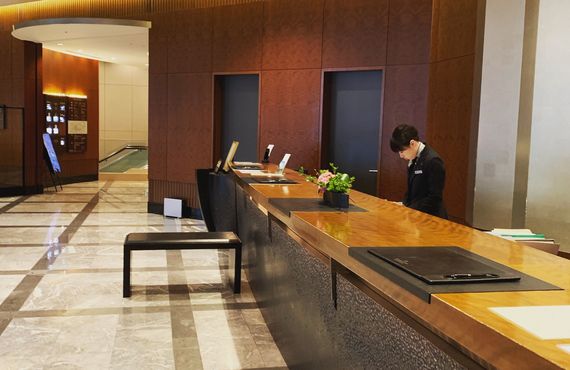
The Cerulean Tower Hotel in Shibuya, Tokyo is an ideal base for your first (or repeat) visit to the city.
I found the Cerulean Tower Hotel in Shibuya (just minutes away from the famous Shibuya scramble crossing) to be ideally situated close to the subways and major airport routes and to many of the most interesting wards in the city.
In Kyoto, which I strongly encourage first-timers to visit, I stayed at the Kyoto Tokyu Hotel, another place I loved. Kyoto is essentially a world heritage site masquerading as a city because it contains more temples and shrines than anywhere else in Japan, many of which date to the first millennium.
It was Kyoto that made me feel at home in Japan, as it turned out. Rising early I was the first person to visit its famous Fushimi Inari Taisha shrine that morning. The cold coming off the hill reminded me of the hills of County Donegal, and the landscape felt as ancient and venerable as my homeland did.
Back in Tokyo, I completed my trip with a stay at The Capitol Tokyu Hotel, a gorgeous and impeccably run five-star that would make an ideal home base for Irish Rugby World Cup visitors.
It was odd to feel so at home so far from home, but I absolutely did thanks to the warmth of the welcome here and the friendliness and consideration I saw all around me.
That trip taught me the Emerald Isle and the Land of the Rising Sun are not so different after all and I can't wait to return.




Comments